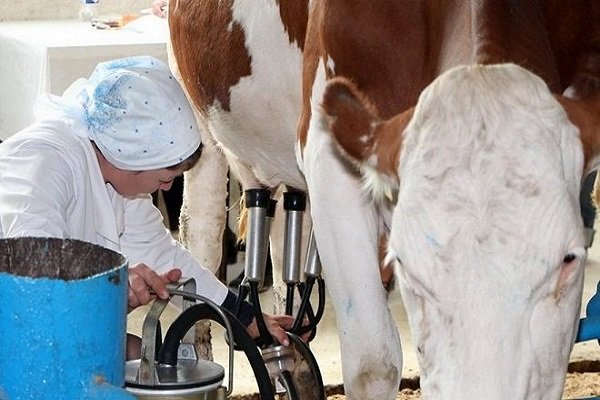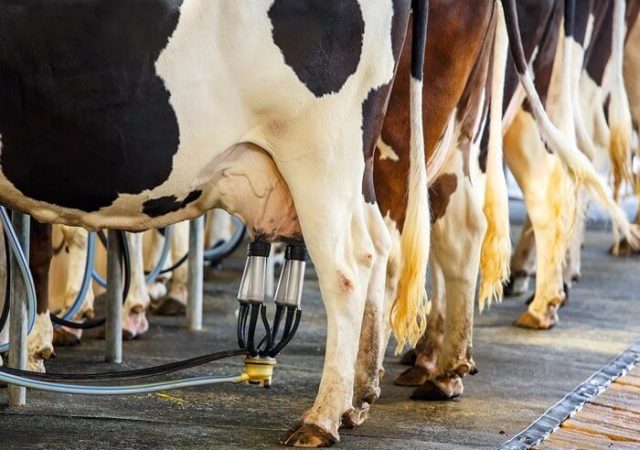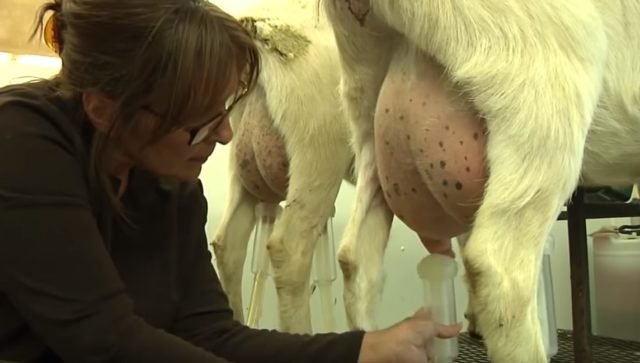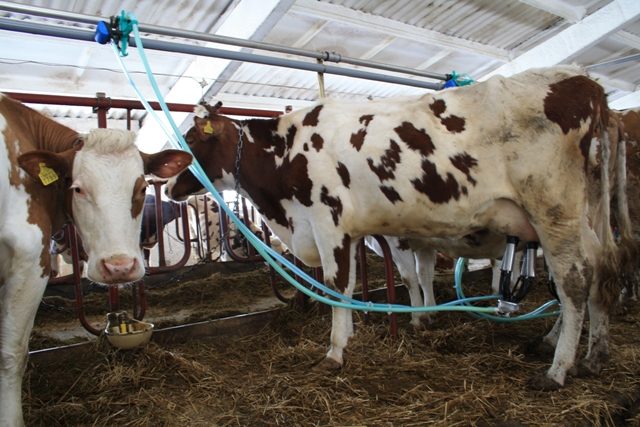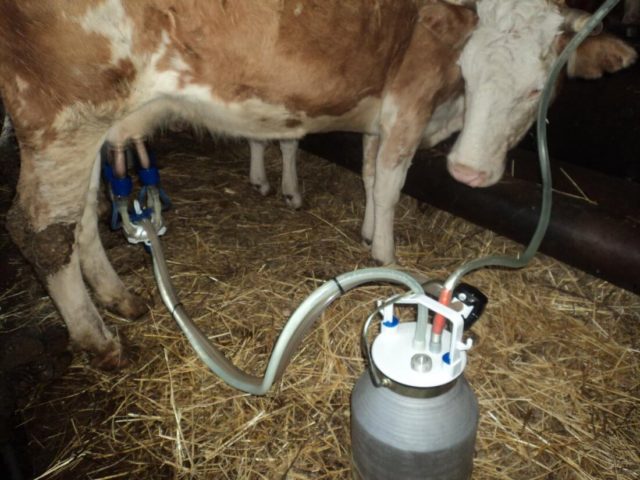Content
Modern technologies that are being introduced into the agricultural sector have led to the fact that almost every cattle owner seeks to train a cow to use a milking machine. With the advent of special equipment, the milk extraction process has been greatly accelerated and facilitated. The cost of the equipment quickly pays off, which is why the device instantly gained popularity among farmers.
Methods of machine milking of cows
There are 3 main ways to get milk:
- natural;
- machine;
- manual.
In the natural way, when the calf sucks the udder on its own, milk production is due to the vacuum that forms in the calf's mouth. For the manual method, this process is due to the squeezing of milk from the teat tank directly by hand by a worker or animal owner. And the machine method implies artificial suction or squeezing using a special milking machine.
The very process of milk flow is fast. It is important that the cow is milked as much as possible - the amount of residual liquid in the udder should be minimal. To fulfill this basic requirement, there are a number of rules for machine and hand milking, which consist of:
- preparatory;
- main;
- additional procedures.
Preliminary preparation consists in treating the udder with clean warm water, followed by rubbing and massage, pumping a small amount of milk into a special container, connecting and setting up the device and putting the teat cups on the animal's nipples. Professional milker operators complete the entire list of procedures in less than a minute.
The main part is the direct extraction of milk. Machine milking is the process of extracting milk from the udder using special equipment. The whole process takes an average of 4-6 minutes, including the machine tool.
The final stage is a series of final procedures - turning off the equipment, removing the glasses from the udder and final treatment of the nipples with an antiseptic.
When machine milking takes place, the milk is extracted from the udder teat with a teat cup. In this case, he performs the function of a calf sucking milk or a milkmaid who mechanically acts on him. There are two types of teat cups:
- single-chamber - an obsolete type that is still used in production;
- bicameral - modern glasses with high efficiency and minimal trauma.
Regardless of the chosen method of milk production, the product is isolated in cycles in separate portions. This is due to the physiology of the animal. The time interval for which one portion of milk comes out is called the milking cycle or pulse by experts. It is divided into bars. They are defined as the period during which one interaction of an animal with a machine takes place.
Machine Milking Principles
The principle of hardware milk production is based on a variety of physiological characteristics of the cow. The principle of stimulation to promote the milk flow reflex has been known for thousands of years.
In the process of milking milk with special glasses, exactly as with the natural suction of the udder by the calf, nerve cells and receptors that are located on the nipples are activated.They are most sensitive to pressure, and when present, an impulse is transmitted to the brain to release oxytocin. After a few seconds, it enters the udder of the animal through the circulatory system.
Milking machine technologies for cows must comply with the following zootechnical requirements:
- milking is not started if the cow has not started milk;
- the preparatory stage should last no longer than 60 seconds;
- milking takes just over 4 minutes, but no longer than 6 minutes;
- the optimal milking speed of a cow is 2-3 liters per minute;
- during the period of greatest milk flow, milk comes out of the nipples completely;
- the process should be adjusted so that there is no need for manual dosing;
- Correct machine milking of cows does not cause harmful effects on the udder and the health of the cow in principle, which is an inevitable consequence of overexposing the teat cups.
The principle of operation of all milking machines is as follows: rarefied air from the vacuum wire enters the pulsator through a special hose, after which it moves further into the space between the walls. This completes one sucking beat. However, in the teat cup chamber under the teat, the vacuum is constantly applied.
For the production of cow's milk are used:
- two-stroke devices on the principle of squeezing-sucking;
- three-stroke with an additional rest period.
When compressed, air from the atmosphere enters the chambers between the walls of the milking glasses, which causes the teats to contract. During the sucking stroke, the pressure in the chambers is stabilized and the milk comes out of the nipple.
Also, due to high pressure and vacuum, blood, lymph and various gases are supplied to the udder, due to which the nipples are significantly enlarged. This is a rather painful process that can lead to pathological changes in cells. That is why the third cycle - rest - was introduced to reduce the negative effect on the tissues. Detailed machine milking of cows is presented in the video at the end of the article.
Preparing the milking machine for operation
A milking machine is a special technical device that comes into direct contact with animals and products. Therefore, it requires special care and preliminary preparation before each milking.
Efficient milking of cows is only possible if the milk extraction system is in good working order and is set up correctly by the operator. Therefore, before starting work, it is necessary to accurately diagnose it for problems and various malfunctions. Correct operation means ensuring the correct pulsation frequency and vacuum pressure. How to achieve these settings is generally described in the milking machine user's manual.
Before starting work, it is necessary to check that the hoses with other parts fit tightly, the liner is intact, and there is a gasket between the edge of the can and the lid. You also need to make sure that there is no mechanical damage on the can, because air can leak through the dents, which will cause all equipment for milking cows with the apparatus to fail.
It should be borne in mind that liners from glasses break the fastest. They will wear out, so it is advisable that the machine operator always have a few extra kits in stock.
Almost all milking installations require regular lubrication of rubbing parts. You can read more about this in the user manual, where the manufacturer himself provides recommendations for using the device.
The very process of basic preparation of the installation for automated milking of a cow is as follows:
- before putting on, the teat cups are heated, for this they need to be held in water with a temperature of 40-50 for several seconds;
- at the end of milking, all accessible parts of the device are also washed - first with warm water, and then with a special cleaning solution;
- the internal parts of the apparatus, which are in direct contact with dairy products, are also washed after each use. This is done with the help of a vacuum, when detergent and disinfectant is run through the entire apparatus instead of milk.
Store the clean apparatus in the position and conditions specified by the manufacturer. Operation in accordance with the rules is the key to quality milking.
How to properly milk a cow with a milking machine
When using automatic devices, it is necessary to follow the following rules for machine milking of cows:
- Before starting the process, you need to inspect the udder of the animal for problems - diseases or injuries. It is also advisable to regularly conduct analyzes for milk compliance with sanitary and epidemiological standards.
- If several cows are serviced by one milking machine in operation, then it is necessary to draw up a special calendar and the order of their processing. A certain sequence must be followed. First of all, those cows that have recently calved are milked, after them are young and healthy, and old and “problem” cows go to milking last.
- Before putting glasses on the teats of a cow, 2-3 streams are manually milked from each udder. All milk must be collected in a special container. Leaving it on the floor is strictly prohibited, as this can lead to an outbreak of disease and the rapid spread of harmful bacteria. A person who works with a cow must be able to visually assess the quality of milk - check for clots, blotches or any other abnormalities in color and texture.
- So that the cow does not develop mastitis, and the milk is clean, with each milking, the teats are washed and then wiped dry. To do this, it is advisable to use disposable paper towels or an individual cloth rag after the milking machine, which is washed after each use.
- After turning off the unit, you need to wait until the vacuum drops inside the glasses. You do not need to pull the cow's udder forcibly to remove the equipment. This can cause mastitis.
How to train a cow to use the milking machine
Preparation for automatic milking of cows takes place in several stages:
- Prepare the udder and the room.
- The cow is gradually adapted to the noise from the apparatus.
Preparation of the udder of the animal includes processing before and after the procedure, and also protects against the formation of mechanical damage in every possible way.
Experts recommend:
- always take milk at the same time;
- carry out the procedure in the same place (then the cow herself will enter her box out of habit), adaptation takes on average 5-7 days;
- the first days in the box, the cow is milked by hand until she gets used to the situation, and then they begin to accustom her to the milking machine;
- accustom the animal to noise - cows are very shy and can experience stress from any unnecessary noise, loud noises from the milking machine can completely stop lactation.
Experts are convinced that it is not difficult to accustom an animal to machine milking.The owner must have patience and understanding with the cow, not be aggressive and not use physical force. So he will achieve success in a short period of time.
Conclusion
The need to train the cow to the milking machine arises as soon as the farmer decides to switch to automatic milk production. It is a convenient and advanced way to set up automatic production, reduce human intervention and speed up product delivery. On average, one procedure takes about 6-8 minutes, including preparatory stages. The equipment itself is easy to maintain. It is important to maintain hygiene and cleanliness, and treat the device with special cleaning agents after each use.
